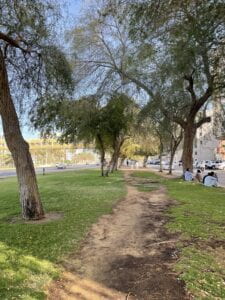Dear Professor Goffredo and classmates,
I want to thank everyone for being part of this eye-opening experience that not only changed the way I think about design but also everything around me. Three months ago, I didn’t know that wayfinding exists. I believed that when a project is planned, all we do is create designs for it for the sake of the aesthetics and that’s it; we don’t need to think about anything else—the project is done, and everything is ready. Looking back, I realize that it is, and will never be, this easy. Every blog post I wrote here documents the moments of progress and realizations I have had throughout the 14 weeks, an evidence how one’s perception of lots of things around him can change so easily. That’s because design is not just a style; it’s a language. My biggest realization from the class is that we don’t master design by learning how to use Photoshop; we learn it by looking into ourselves, trying to master, understand, and expect how we think.
Therefore, I want to use my last blog to share with you and remind my future self of all the main takeaways from this class that were transformative for me, which I summed up in the following tens points.
- How you present the idea can be more important than the idea itself.
I’ve learned in this course that creativity is never enough. If you can’t present the product of your thought in a clear way that is as superb as your idea, then no matter how creative you’re, your idea/work might end up not being as successful as you expect.
2. If your first sketch for an idea is good, DON’T stop.
It feels great to find an idea from the first time you start working on a project, I know. However, think about it. If this is your starting point—your first sketch. For some reason, you decided to stop at that point. By doing that, you lose the opportunity to come up with something that is really impressive. Just imagine how amazing your final sketch will be if you keep on trying, sketching, and editing. In the end, you’ll come up with the best idea possible. Don’t settle for your first idea.
3. If the user can’t use/understand it, then it is not his fault.
This class taught me how to be sympathetic towards myself. I no longer blame myself when I cannot open something from the first time, or when I fail to find the turn-on button for the iMac screen. I now know that bad design exists, and I’m not, as a user, the one to be blamed. While this realization makes me feel good about myself, it also leaves me in constant fear that I might commit the same mistake of bad design in my projects. In my opinion, one should always keep an attentive eye to notice such errors.
4. Don’t be afraid to share your work. It might get harshly critiqued, but it is a free opportunity to learn
I think that one of the problems designers in general face is the fear of sharing work. Most of us fear being criticized or have what we created get critiqued. I learned in this class that a designer’s lifetime goal is to always seek improvement. How do you improve? It’s easy: ask those around you and start a discussion. See what they notice, what their comments are, and how they feel about your work. Probably my favorite moment in this class was when I presented my cheatsheet on Visual Explanations’s chapter two by Edward Tufte. I was happy to see how everyone was willing and open to share what they found wrong about the slides or what looked off. I wrote down all their comments, and I still have them till this day that. Whenever I work on a presentation, I will make sure not to make the same mistakes again.
5. Feedback is free. Always ask for it.
I will probably be using this advice forever in my academic career. For some reason, we students always get distracted by the requirements of an assignment, forgetting that the source himself (the professor or the TA) are always there to help. If you feel stuck, just ask for their opinion. Professor Goffreddo once said something along the lines of: “I’m the one who will be evaluating this. So it makes sense that if you feel the need to ask about something, just send me an email.” I think this is important as we, for some reason, might get overwhelmed to the point that we are both wasting time and making no progress, while, in fact, the solution is in front of us.
6. Appreciate your years at NYUAD
Professor Goffredo once said that if you are part of a design agency and you have to do international work, you’ll have to work with a diverse group of designers from different parts of the world—something that is really expensive. We, at NYUAD, have diversity of all kinds for free here. All we have to do is just go to D2. That’s it. Literally. In other words, we should make use of our university years, appreciate them, and try to learn as much as possible from our colleagues.
7. Design is a universal language, but take care
While the psychological behavior of us humans is somewhat similar (our reaction to nudges, for instance), that doesn’t mean that what applies somewhere applies elsewhere. Professor Goffredo once told us about the story of the hand gesture that a police officer made, which the Professor misinterpreted as it means something offensive in Italy. Few days ago, I came across a post on Twitter that said that the poster of the Movie Doctor Strange in the Multiverse of Madness was edited to suit the Italian audience because of an inappropriate hand gesture that Doctor Strange makes in the original poster. This reinforced my belief that designers should put extra effort to make sure that none is offended by their work.

Marvel’s Doctor Strange in the Multiverse of Madness poster before and after
8. Creativity is a skill you can nourish and boost
The beautiful thing about design is that there is no limit to what one can create. Even if you know nothing about it, with some creativity, you can do a lot and bring insightful opinions to discussions. If you’re not creative, then don’t worry. It’s a process that takes time, and with practice, you’ll be amazed at how fast your mind becomes capable of finding ideas in short periods of time.
9. We learn (and get inspired) by sharing
Seeing my colleagues’ work throughout the semester has always been inspiring to me. Every time I left my desk to check my colleagues’ work on their computers, I found that I always learned something new, got inspired, or found a mistake that I knew I might need to avoid in the future. Indeed, that moment of all of us sharing our work together at the same moment was priceless, and it made learning exponential.
10. You’ll never stop learning
Perhaps this is the most important point I realized from this class. Seeing Professor Goffredo’s passion with his guests, and how he, even after all these years of teaching, is always open to that moment of new realization that will change his perception of design and “unlocks something new” was indeed inspirational. It taught me that a student of design should always do away with his ego and be open to that one simple concept that he might not notice at first sight but will blow his mind once he does.
To me these were the top 10 lessons I’m glad I’ve learned in this class. While they might not appear related to wayfinding, I believe this couse was not just about wayfinding. It was never about the roads, the ways, or whatever. It was always about us humans trying to find our ways around. It was always about us understanding ourselves so we can predict our next move, and that’s the whole idea of design.
To everyone,
Thank you!
P.S. Attached is an image of a desire path I came across today.

What an excellent way to wrap it up. Thank you Abdelrahman. You have been quite an asset for the whole class.
That is an excellent blog post! This offered me valuable insights on what I should definitely not forget from this class! I can personally attest to the feedback part, because the professor really helped me advance my “Impossible Pictogram” assignment. Thanks to his valuable suggestions, I was able to turn an average idea into an exciting pictogram (in my opinion at least).
Thank you so much for sharing your great insights about the class. Your words remind me of all the exercises and lectures we had and I’m really moved. What I love about this course is that it not only teaches you knowledge about design and wayfinding but teaches you how to learn. And I have changed because of the class. For example, now I perform much better in planning ahead than I a year ago. The number of times I procrastinate things until the last minute is fewer and fewer and I benefit so much from this.
Hi Abdelrahman!! I really enjoyed reading this post, wrapping up your learnings from the class – specifically focusing on the life skills that can be applied in any field we go into. I think point 4 and 5 – asking for criticism and feedback / welcoming it more than fearing it is also one of my biggest getaways from this class. I also like your point on how creativity is something you nourish and practice. I think I will come back to your post once in a while to be reminded of these learnings we all took away from this class. Thank you for such an insightful blog post 🙂